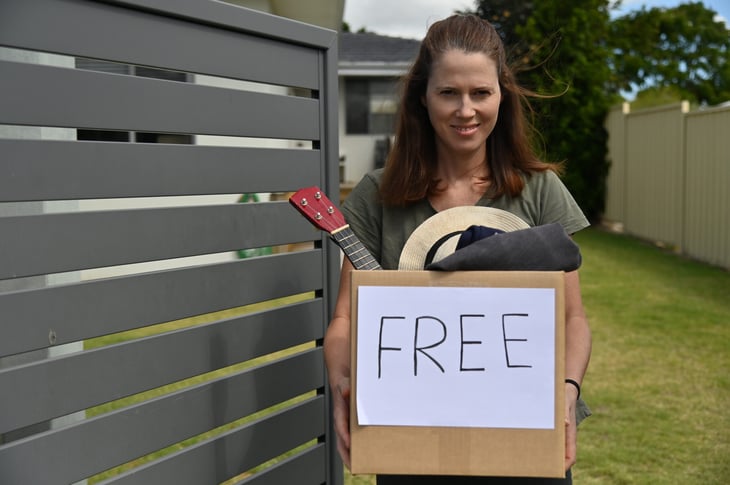
In times of rising inflation, “overspending” doesn’t always feel like a choice that you made. It feels like something you can no longer control.
After all, you can’t push your car to work — you have to put gas in it, no matter how much that costs. Your kids will keep outgrowing their shoes even though replacing them gets spendier with every new pair. Property taxes keep going up because the housing market has determined your modest ranch home is now worth 50% more than when you bought it.
It’s also possible that some of your budget woes are due to bad habits — an “instant gratification” mentality or failing to look for the best deals before you buy.
Fact is, spending more than you earn — or even almost as much as you earn — is not a sustainable way to live. Prices are going to keep rising, so a savvy consumer has to find ways to meet their needs without breaking the bank. The following tactics can help.
1. Track your spending

Plenty of people have no idea where their money goes each month. They just know that it’s gone. To get control of your cash, keep track of how it’s being used. Yes, every dollar, for a month.
You can use pen and paper if you want. Or let technology handle it by using a budgeting tool like You Need A Budget, which tracks your expenses, monitors your goals and shows the progress you’ve made.
Once you’ve figured out where your money is going, you’ll be able to …
2. Build a budget that works

To be clear: “Budget” does not mean “punishment.” Quite simply, a budget is just a plan for your spending.
A popular version is the 50/30/20 budget: No more than half of after-tax income goes toward necessities, 30% is for things you want, and 20% is designated for savings and debt repayment. Thus food/shelter/utilities would go under the 50% category, a car loan under 20% and treats or other fun stuff in the 30% section.
This is somewhat flexible, incidentally. If paying off consumer debt or beefing up an emergency fund is important to you, feel free to add money from your “wants” fund to the savings/debt repayment category.
3. Sign up for rewards programs

I boost my budget with rewards from shopping apps like Ibotta, Shopkick and Fetch as well as from programs like MyPoints, Swagbucks and InboxDollars. The points that I earn help pay for things like food, household items, toiletries, supplies for our vegetable garden and even movie tickets.
These apps and programs feature a wide variety of possible rewards; and, in some cases, you can even select PayPal, which means literal cash in your pocket.
They’re also a great way to give presents even if your budget is tight. For example, I gave my BFF a $50 gas station gift card for her birthday that I had earned from a rewards program. Who’s gonna turn that down?
4. Get a rewards credit card

If you can get a rewards credit card, do so. You might opt to apply the rewards toward your next credit card statement, which eases the bite on your budget.
Or cash in on gift cards to help pay for food, housewares and other daily necessities. To find the best rewards cards out there, check out the Money Talks News Solution Center.
Remember, though: This is not a license to overspend! It’s just a way to reduce the cost of the things you need to buy.
Pro tip: Sign up to pay cellphone and other utility bills with a rewards card. Not only do you get a small kickback, it also ensures you’ll never again have a late payment notice or fee.
5. Learn to cook

We’ve said it before, and we’ll say it again: Of all budget categories, food has the most wiggle room. There’s nothing wrong with takeout now and then, but a steady diet of food someone else cooked will torpedo your finances.
You don’t know how to cook? Well, you didn’t know how to use a smartphone or drive a car either until you learned. Here are a few ways to get started:
- BudgetBytes.com is full of recipes that are both easy and affordable – some plain, some fancy.
- Food scholar Leanne Brown’s “Good and Cheap,” based on the SNAP (food stamps) budget of about $4 per day, is available as a free PDF download (in English and Spanish).
- A Year of Slow Cooking shows how to cook everything from appetizers to desserts in a slow cooker — all of it gluten-free, although you can tailor the recipes for those who do consume gluten.
6. Grocery shop with apps

Apps like Magic Receipts, Ibotta, Shopkick and Fetch can make a big difference in your grocery budget’s bottom line. They’re not just for sweets and snacks either; you’ll see rewards for fresh produce, meats and vegan, organic and keto-friendly products up for grabs.
Some of these deals are killer. Recently I was being paid 20 cents per bag to buy Malt-O-Meal cereal (which I donated to a food bank). I also got paid to buy freshly sliced deli meat. Can’t argue with free.
Learn more at “7 Apps I Use to Beat Inflation at the Grocery Store.”
7. Delay gratification

You want to replace your phone, even though it’s only a couple of years old.
Those ankle boots are pretty darned cute, but don’t you already have a few pairs?
The latest version of your favorite video game just dropped and you’re sorely tempted, even though you haven’t beaten the previous version yet.
Replace that instant gratification habit with a new mentality: “Wait and see.” Waiting gives you time to research prices, set aside money to pay cash and, yeah, decide whether you really need that whatever-it-is.
A big part of delaying gratification is learning to …
8. Discern between wants and needs

Food, shelter, utilities, basic clothing and debt service are all needs. Everything else is pretty much a want.
No one is saying you can’t have nice things — but if you can’t really afford them, you can’t have them right away. That budget we talked about earlier should include a category called “wants,” i.e., dollars you can use for fun. And, of course, make sure that you’re getting the best price for both needs and wants.
And if it turns out you really do need a particular item? Maybe you should …
9. Go secondhand

Thrift stores, consignment shops, yard sales, Facebook Marketplace — you might be able to meet many (or all) of your needs without paying retail. A few helpful resources:
- TheThriftShopper.com, which you can search by ZIP code
- Garage Sale Finder or Garage Sales Tracker
- The online store locators of Goodwill, Salvation Army and national chains like Play It Again Sports and Plato’s Closet
In some cases, you might be able to …
10. Borrow, not buy

Want to power-wash your deck, take your kid fishing or teach yourself to play the banjo? Instead of buying or renting the needed equipment, see if you can get it for free. A few sources:
- Ask around at work, on social media or at your place of worship — somebody might lend you that power washer or fishing rod.
- If you’re part of a Buy Nothing Facebook group, ask for a loan or gift of what you need.
- Some public libraries provide offbeat loaners, from cake pans to power tools.
And if it’s something you’ll use a lot, or just want to have for your own? Look for ways to …
11. Find free stuff

Who doesn’t love a freebie? While some fairly sketchy freebie sites are out there, it really is possible to get free food, toiletries, housewares, baby items, pet supplies and other necessities and fun stuff.
Sometimes the rewards are considerable, e.g., on furniture or electronics. Or you might just enjoy getting a chance to try a product before buying it, which can save you money later if you find out that this particular laundry detergent made your kids break out in hives.
Learn more in “6 of the Best Websites for Finding Free Stuff.”
12. Move to a cheaper place

Has your rent inched (or jumped) up in the past couple of years? Maybe it’s time to think about downsizing instead of spending a huge chunk of your income on a place to stay.
Fact is, your rent is likely going to keep going up — and the more you spend on rent, the less is left over for meeting necessities, let alone your future financial goals. Consider looking around for cheaper digs — or taking in a roommate to share the monthly burden.
13. Get a side hustle

If you can’t earn enough to pay for the fun extras in your life, don’t keep overspending on them. Instead, look for ways to bring in more money. That could mean:
- Finding a part-time job like delivering pizza or groceries
- Working 10 to 12 hours a week at a traditional retail gig
- Turning a hobby or talent into an income source
You could also look for a work-from-home job that reduces the amount of driving you have to do and that may also let you work in your PJs. “25 Side Jobs That Can Be Done From Home” is a good place to start.
14. Get a better insurance rate

It’s foolish to skimp on auto or homeowners insurance or, heaven forfend, to go without such coverage. Either decision could wreck your finances.
But why shell out more than you must each month for this essential protection? Instead, read this car insurance guide. You’ll learn how to get the best prices for the robust protection that precisely suits your needs.
This isn’t one-time savings either. You’ll save money year after year. Think of how all that money you aren’t overspending could support your future financial goals.
Don’t stop there though. You could also …
15. Find the best deals on everyday needs

If there’s a better price for a comparable cellphone plan, wouldn’t you want to know about it? Or how about info on the best rates for savings accounts and CDs, travel, credit cards, HELOC, personal loans or mortgages and mortgage refinancing?
Again, the Money Talks News Solutions Center is ready to help you. Those solutions might be something you’d never considered before. For example, suppose you can’t seem to pay off a high-interest credit card. Taking out a personal loan at a much lower interest rate could let you clear the slate instead of throwing money at a debt that refuses to shrink.
Visit the Solutions Center and learn not just how to stop overspending, but how to leverage your current funds to get the most from every dollar.






Add a Comment
Our Policy: We welcome relevant and respectful comments in order to foster healthy and informative discussions. All other comments may be removed. Comments with links are automatically held for moderation.